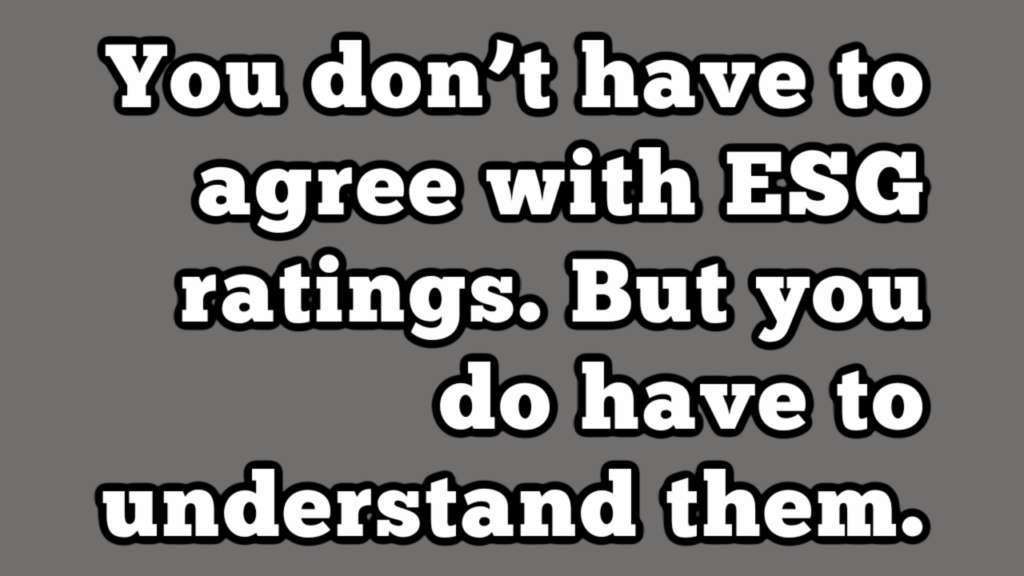You don’t have to agree with ESG ratings. But you do have to understand them.

– Fund managers need to do their own due diligence when it comes to ESG rather than rely on rating services.
– ESG data is as good as the user.
In response to this article, Matt Moscardi – host of the “Business Pants” and “Market Medium” podcasts posted this note on LinkedIn:
I’ve been in ESG a while, but I’m pretty tired of the knee jerk reaction of saying “this is not ESG.” While I like a good game of “define a thing by what you don’t like about it,” it’s a waste of time. When you understand the guts of the Refinitiv ESG model, it makes a LOT of sense how the Top 5 ESG companies look this way. Park the outrage because the methodology WORKS AS DESCRIBED.
The problem isn’t the list. The problem is the ESG community. We love to harp on standards – how much we need them – and data – how bad it is – but are we really demanding a new kind of “ESG group think”? Don’t we already have that in traditional financial metrics?
I lived through this for 10 years at MSCI, being told our list was wrong or our data sucked. But we created. And we had our reasons. I’m guessing the same is true of Refinitiv, an LSEG business, Sustainalytics, ISS | Institutional Shareholder Services, and Truvalue Labs, a FactSet company or your own “prop” ratings. You do NOT HAVE TO AGREE with the ratings, lists, or reasons. You have to KNOW them, be creative, and make informed decisions. Or, as Bill Belichick says, #doyourjob.
And then here is this note from Matt that links to this article entitled “ESG’s dirty secret”:
Here’s a choice quote: “Two of the biggest business scandals [#Boohoo and #Wirecard] of the year proved poor #social and #governance standards do have a #material impact on #shareholders. But they also showed #ESG investing may not be smart enough to avoid the risks.”
Not included: the fact that most sell side analysts had Boohoo as a strong buy. The article goes on to say “Critics say ratings providers assess companies through box-ticking exercises and obscure algorithms, so can overlook issues that are transparent to the human eye…”
Here’s a critique for you: STOP ASKING SOMEONE TO DO ALL YOUR OWN DUE DILIGENCE. ESG data is as good as the user. If you hope that an index fund called “#sustainable” or a rating saying “great at ESG” is the answer to all your ESG investing problems, you fail. The data sucks sometimes, deal with it. The ratings don’t predict all the futures, oops. A lot of stone throwing at ESG, not a lot of innovating or creating. I get told “no” at virtually every meeting with clients – “that won’t work” or “the data isn’t good enough” or “we disagree with that methodology.” Want to know how often I’ve heard an alternative idea? Zero. Zero times.
And finally, see this note from Nawar Alsaadi:
If you follow the ESG field long enough you will undoubtedly hear the criticism that ESG ratings differ between ESG rating providers, and this an issue we need to solve. This observation seems to confuse ESG ratings with ESG disclosure, for sure we need a standardized ESG disclosure framework, but ESG ratings are a different story.
In essence, valuing ESG risks is no different from valuing financial risks in the sense that financial analysts rarely agree on a value of a security despite having access to the same financial disclosure. With this in mind, why should it be any different for ESG risks? ESG risks come in different forms and colours, it takes skill, experience and foresight for these risks to be properly valued in an investment context. Expecting a uniformity of outcome amid a diversity of process is illogical.
This is exactly why investors must take special care when choosing who they trust when it comes to their responsible investing portfolio. In the ESG investing field process and experience matters a great deal.
